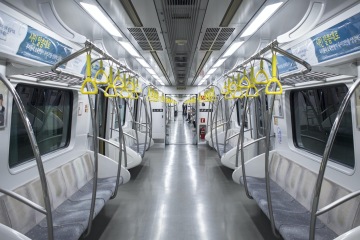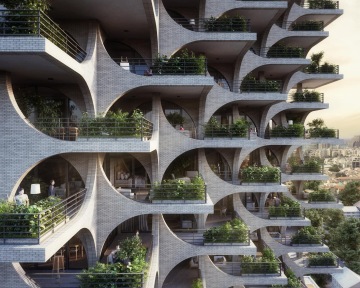
What Topics Will Define Cities in the 2020s?
We take a deeper look into some of the issues and topics that will shape our cities and the lives of its dwellers as well as what remedies could build better cities in the decade to come.
Over the past decade, cities across the globe have both undergone rapid transformations and gained a more acute awareness of not just what is lacking in our cities, but how we have shaped them for better and worse thus far. With the growing presence of technology, evolving populations, gentrification, climate change and beyond we expect to see cities evolve exponentially in the 2020s.
Here are eight selected trends that we believe will have their contribution in shaping the lives of cities and its dwellers in the decade to come. With this sort of awareness, we can steer ourselves to more inclusive, sustainable, attractive, intelligent and livable cities for all.

Car-free movements
As private vehicles cease to be the pivotal element in urban planning and policy-making, there are major indications the cities in the 2020s will lean towards cutting down their car traffic. As for the moment, it is explicit that all the major metropolitan areas, although unevenly, are implementing a variety of restrictions on car movement, maintenance or purchasing.
Simultaneously, alternative modes of transportation are gaining support amongst the wider populations creating the ever-rising pressure on stakeholders and policymakers to accommodate the needs of its adherents. The same mechanism is true for the private sector where the consumer pressure is spurring the gradual elimination of private vehicles in the areas that span beyond transportation. Thus, for instance, a vast amount of new residential developments and housing projects are designed for car-free living. Initially fearful of loss, the present-day developers are now aware of the new generation’s commitment to no longer rely on private vehicles striving for sustainable, shared mobility conceived as a service.
Self-powered cities
The ongoing climate crisis is setting a huge precedent for what this next decade will look like across the board. Thoughtful use of natural resources while rethinking powering strategies can hardly be considered a trend anymore, but an imperative necessity. Especially for the cities that are believed to account for the majority of all the CO2 emissions. There has already been a significant shift in the affordability of renewable energy solutions, and there are reasons to believe those will only become more cost-efficient in the decade to come.

Inclusivity
Over the last decade, our awareness of the direr need for inclusivity in our cities has heightened greatly. This shouldn’t perhaps be put in a single paragraph, for the questions of social justice are relevant to each and every one of the urban trends that are shaping the nearest future. It is important to remember that social inclusion doesn’t just correlate to economic growth, however, research indicates that well-off cities still have a tendency for greater inclusion than those economically distressed.
Despite roughly global tendencies for economic austerity, it is believed that the quest for a juster society will only intensify in the 2020s. The decade to come will see cities more inclusive of the LGBTQ+community, people with physical or mental disabilities, women, historically marginalized groups, and the displaced. Inclusion will mean not only participation in decision-making but also the human scale and diversity of human bodies being recognized by spatial design and architecture.
Climate gentrification
The 2020s will see more of what Jesse M. Keenan of Harvard School of Design coined as “climate gentrification”. The science is quite clear-cut — we are on the horizon of a global environmental catastrophe with the recent revelations suggesting that its pace is even more frantic than initially believed. For cities, this means that rising temperatures, flooding, and other natural disasters will create a new type of refugees — those economically well-off, but bound to flee their homes in search of property in climate-stable areas.
As an effect, rent & housing prices in traditionally overlooked neighbourhoods are expected to soar. Spurring gentrification processes will predictably cause the most vulnerable being forced out of their neighborhoods, putting multiple communities at risk. Municipalities and national governments will have to work out solutions to intervene with housing and accommodation prices and secure equal access to safe spaces for all.

Aging populations
For the first time in human history, the population aged 65 and over has exceeded children under 5 years old, and there’s no single implication to believe this trend will revert in the next 10 years. According to the United Nations, the population aged 65 and over is growing faster than all other age groups and by 2050, one in four persons in Europe and North America might be aged 65+.
The increase in the number of the elderly is especially critical in metropolitan areas with more people choosing cities over traditional suburbia as places to enjoy their retirement. Nevertheless, it can still be terribly arduous for an elderly person to get by in a big city. With older residents playing an increasing role in shaping the cities in the future, the latter will have to address the needs of the former in terms of leisure, participation, transit and accessibility.
Smart cities and surveilance
The pictures of the future of smart city solutions painted by experts and commentators are equally as hopeful as they are terrifying. What smart city technologies will eventually turn out to be is hardly possible to foresee, but certain practices in its use registered today might already seem quite alarming. International studies suggest that at least 75 out of 176 countries worldwide actively use AI for surveillance purposes. Whilst global deployment of AI is rapidly increasing, so do the concerns about privacy, algorithm bias and the opacity of its operation. Therefore, the decade to come will feasibly see the quest for greater accountability in smart technology deployment and public access to collected data.

Density
Urbanists have long deemed density as one of the key indicators to efficient urban development. With sustainability being a salient goal impeding the majority of cities around the world, it has only come to be more influential of a concept. Over the years cities have been making an attempt in tackling urban sprawl and decentralisation. As urban populations continue to grow into the decade to come, designers and architects will have to come up with creative use of leftover space. The same applies to adaptation and regeneration. As we can no longer afford to build anew, we will have to find ways to creatively adapt and reuse existing buildings for emerging new demands.
Affordability
There’s a general consensus to the fact that housing across major global cities has increasingly become unaffordable over the past decade. General affordability is comprised not only of reasonably priced property, but the affordability of maintenance costs as well as the proximity of transport and social infrastructure.
What constitutes this grave disruption of contemporary cities is the ever-rising housing market pressure combined with the lack of significant increases in wages. Those who choose rent over purchasing as a result of increasing unaffordability, are equally bound to deal with soaring tenancy prices. Given that housing is undergoing these ventures, it is likely we will see significant shifts in what constitutes the core element of urban living.
More ideas on building future cities from reSITE
Seven Ways COVID-19 is Reshaping our Cities
The novel virus COVID-19 has upended our lives. As it spreads across the globe, it is keeping us contained in our homes and reshaping our relationships with cities.
Six Ways to Create the Cities of the Future by 2050
reSITE's salon series My City/Your City: City of 2050 returned with a conversation on what cities of 2050 will look like.
Eight Quotes Stuck in Our Minds From reSITE 2019 REGENERATE
Here are some of our favorite quotes we still have stuck in our heads from the 8th annual event keeping us inspired - and mindful - in how we go forth in designing and developing for future generations.
A New Generation of Architects with Chris Precht
Chris Precht’s aim to reconnect our lives to our food production by bringing it back into our cities and our minds can be found throughout his architecture. Listen as he discusses the importance of authenticity, creating spaces that activate our senses, and looking at our objective reality to solve the problems of our time.




